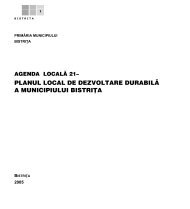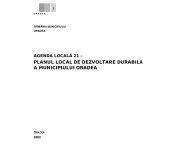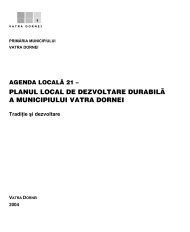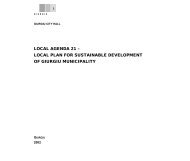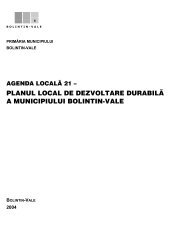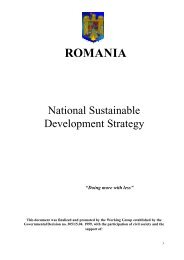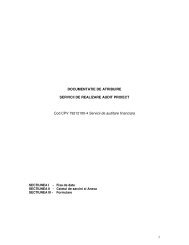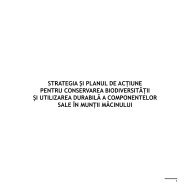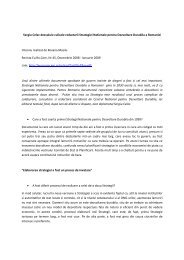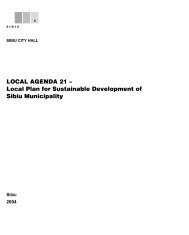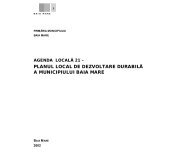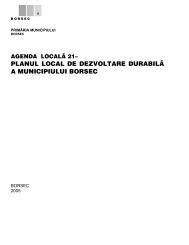local agenda 21 local plan for sustainable development of bistriþa ...
local agenda 21 local plan for sustainable development of bistriþa ...
local agenda 21 local plan for sustainable development of bistriþa ...
Create successful ePaper yourself
Turn your PDF publications into a flip-book with our unique Google optimized e-Paper software.
III. 2 SOCIAL SERVICES CHILD<br />
PROTECTION<br />
Identifying problems<br />
Children with special needs<br />
On 1 April 2004 a number <strong>of</strong> 780 children with special<br />
needs were attending classes in 4 special units within<br />
the municipality area.<br />
- Special school no.1 Bistrita: 192<br />
- Special school no.2 Bistrita: 190<br />
- Pr<strong>of</strong>essional school Sf. Maria Bistrita: 336<br />
- Special school Lacrima Unirea: 62<br />
Programmes and services developed between 1997 and 2004 in Bistrita municipality<br />
1. Residential-type protection<br />
62<br />
MUNICIPALITY<br />
This type <strong>of</strong> institution does not encourage<br />
relationships with parents/extended family or the<br />
community the child comes from, making reintegration<br />
within the family and pr<strong>of</strong>essional environments.<br />
Another important aspect is represented by the huge<br />
costs that a residential regime involves, the children<br />
with disabilities not being able to benefit from the<br />
entire range <strong>of</strong> services they need.<br />
Evaluation <strong>of</strong> the children proved the following:<br />
<strong>of</strong> the 382 children in the 2 special schools in Bistrita:<br />
- 103 children need protection in services <strong>of</strong><br />
residential type<br />
- 63 children can attend the daily centres<br />
- 64 children could travel daily to the centres<br />
- the rest attend school daily<br />
On 1.07.1998, the County Department <strong>for</strong> Children Rights (DJPDC) took over the protection units located in the<br />
municipality, including the children’s shelter with 151 children between 0 and 3 years old. The trend in the number <strong>of</strong><br />
children since the takeover is as follows:<br />
CENTRE<br />
BISTRITA<br />
Number <strong>of</strong> children<br />
on 12 June 1997<br />
Number <strong>of</strong> children<br />
on 01 July 1998<br />
Number <strong>of</strong> children<br />
on 01 Jan. 1999<br />
Number <strong>of</strong> children<br />
on 01 Jan. 2000<br />
Number <strong>of</strong> children<br />
on 01 Jan. 2001<br />
Number <strong>of</strong> children<br />
on 01 Jan. 2002<br />
Number <strong>of</strong> children<br />
on 01 Jan. 2003<br />
Number <strong>of</strong> children<br />
on 01 Apr..2004<br />
151 113 82 78 91 95 38 31<br />
75 % 54 % 51.5 % 60 % 63 % 25 % <strong>21</strong>%<br />
The most important indicator is the average number <strong>of</strong><br />
months a child spends in an institution: 70.92 months<br />
be<strong>for</strong>e the DJPDC takeover, 18.89 months in 2000,<br />
9.7 months in 2001 and 7.8 months in 2002.<br />
In the third trimester <strong>of</strong> the year 2002, the percentage<br />
<strong>of</strong> children aged between 0 and 3 was <strong>of</strong> 3.7% from<br />
the overall number <strong>of</strong> children in institutions in Bistrita<br />
Nasaud, compared with 6.7% at national level. The<br />
deinstitutionalisation indicator <strong>for</strong> the same period is<br />
12.11%, compared with 8.20% on a national level.<br />
Children who returned to their families are considered<br />
successful cases. They remain in the attention <strong>of</strong> the<br />
service and are supervised until relations with their<br />
family members become normal again.<br />
Re<strong>for</strong>m institutions<br />
I. The discontinuities that appear in the process<br />
<strong>of</strong> nursing a child due to the transfer from one<br />
institution to another or from one group to another<br />
within the same institution have negative effects <strong>for</strong><br />
the future <strong>development</strong> <strong>of</strong> the child. In order to<br />
diminish these phenomena, the Bistrita placing Centre<br />
modified the category <strong>of</strong> interned children: from 0-3<br />
years to 0-7 years.



